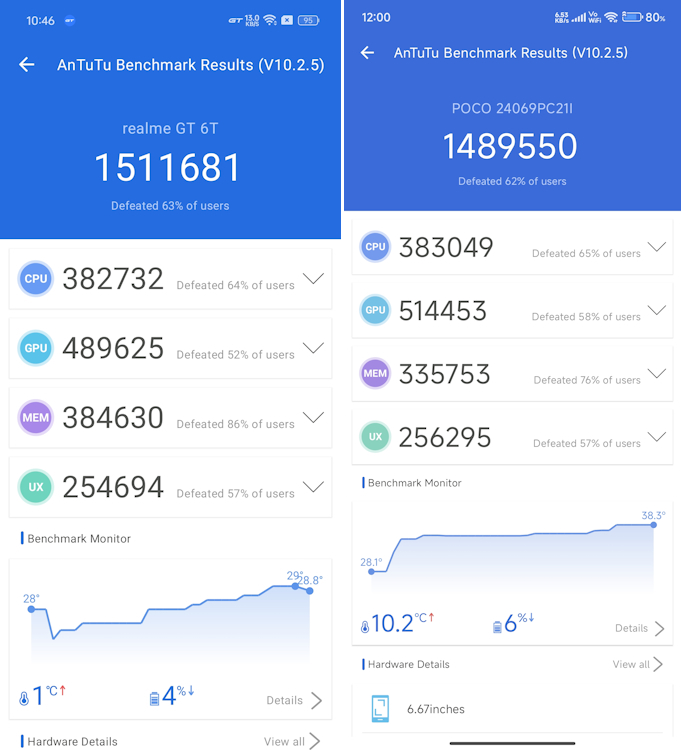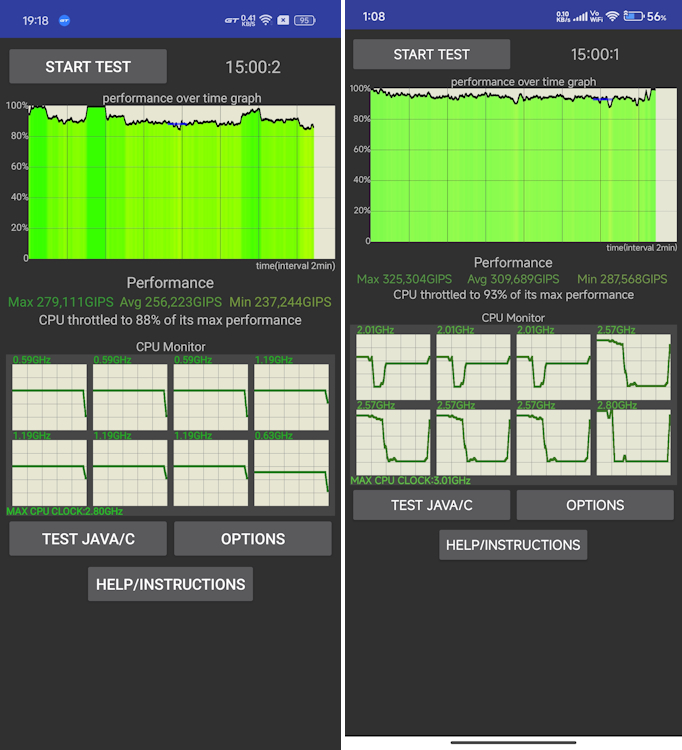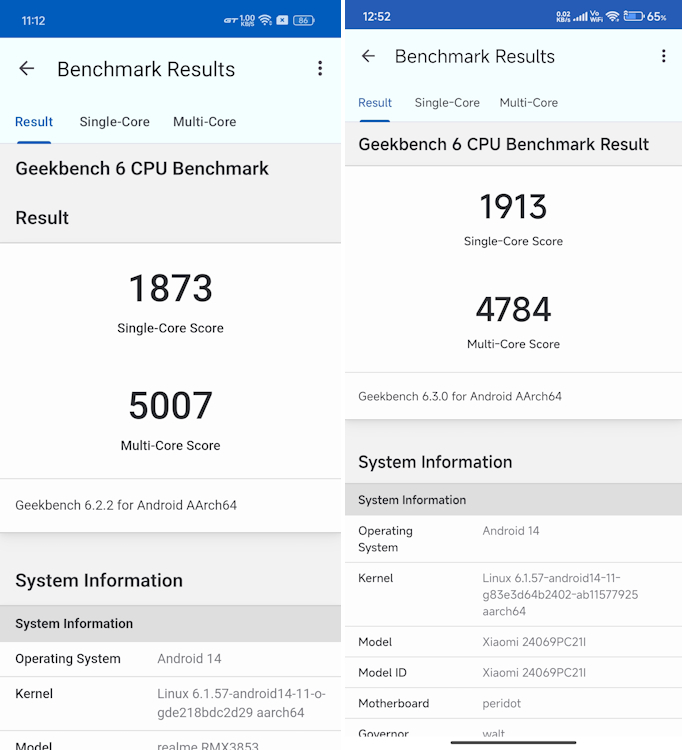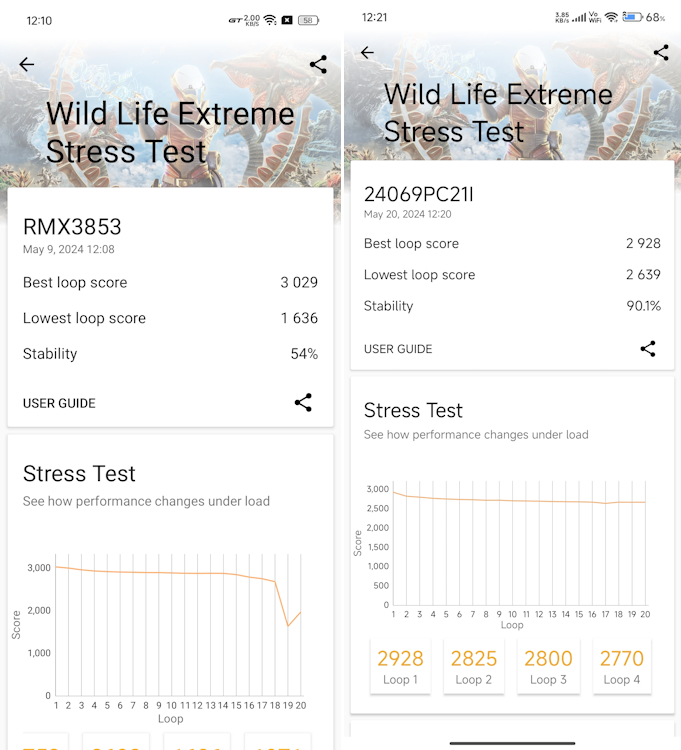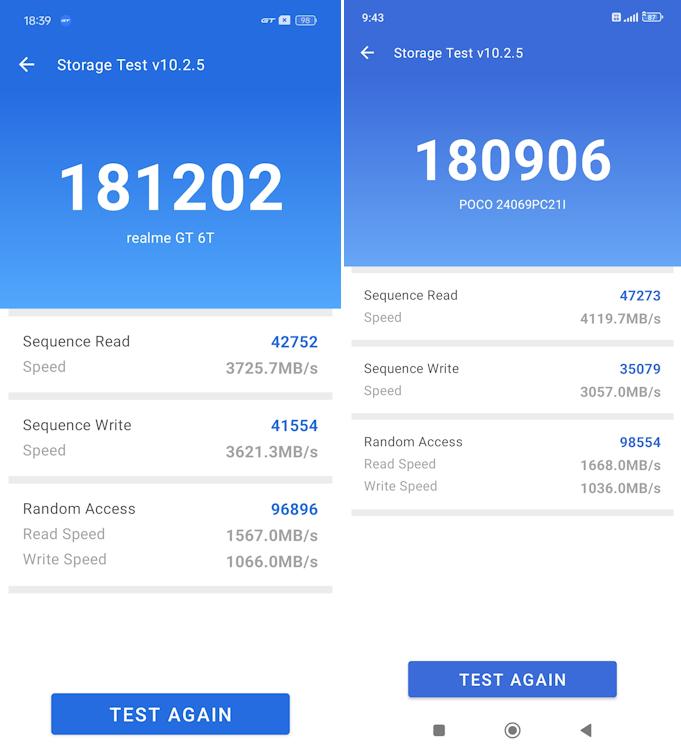The market is suddenly awash with high-performance mid-range smartphones, and the Realme GT 6T and POCO F6 are the new stand-out frontrunners. With the Snapdragon 7+ Gen 3 powering the GT 6T and Snapdragon 8s Gen 3 in the F6, it’s a hard choice to make. What makes it even harder is that the pricing of the two phones is just Rs 1,000 apart.
While I did review the Realme GT 6T and my colleague Anshuman took care of the POCO F6, we didn’t directly pit the two against each other. Well, a detailed comparison was the need of the hour and here I am. With that being said, let’s jump right into Realme GT 6T vs POCO F6 comparison.
Realme GT 6T vs POCO F6: Specs Comparison
| Specs | Realme GT 6T | POCO F6 |
|---|---|---|
| Dimensions | 162 x 75.1 x 8.7 mm | 160.5 x 74.4 x 7.8 mm |
| Weight | 191 grams | 179 grams |
| Processor | Qualcomm Snapdragon 7+ Gen 3 (TSMC 4nm) | Qualcomm Snapdragon 8s Gen 3 (TSMC 4nm) |
| RAM/Storage | 12GB LPDDR5X/ 512GB UFS 4.0 | 12GB LPDDR5X/ 512GB UFS 4.0 |
| Display | 6.78-inch 1.5K + 120Hz LTPO AMOLED, 2780 x 1264 pixels, 450 ppi, 6000 nits peak brightness | 6.67-inch 1.5K + 120Hz AMOLED, 2712 x 1220 pixels, 446 ppi, 2400 nits peak brightness |
| Rear Camera | 50MP Main + 8MP Ultra-wide | 50MP Main + 8MP Ultra-wide |
| Front Camera | 32MP | 20MP |
| Video | Up to 4K at 60FPS | Up to 4K at 60FPS |
| Dual SIM | Yes; Does not support eSIM | Yes; Does not support eSIM |
| Connectivity | 9 5G bands, Wi-Fi 6, Bluetooth 5.4, NFC, IR Blaster | 15 5G bands, Wi-Fi 6, Bluetooth 5.4, NFC, IR Blaster |
| Port | USB Type-C | USB Type-C |
| Battery | 5,500mAh | 5,o00mAh |
| Charging | 120W fast charging | 90W fast charging |
| IP Rating | IP65 | IP64 |
| Software | Android 14, Realme UI 3 years of OS updates | Android 14, HyperOS 3 years of OS updates |
Realme GT 6T vs POCO F6: Performance


Without beating around the bush, I’ll get straight to what you are here for – the performance. Then, we’ll move on to the other things.
While the Realme GT 6T arrives with India’s first Snapdragon 7+ Gen 3, the Snapdragon 8s Gen 3 powers the POCO F6. Yes, the chipset monikers can make you go bonkers, and you can take a look at this detailed explainer for Snapdragon’s complex naming scheme. But, simply put, the 8s Gen 3 is just a slightly overclocked 7+ Gen 3.
So, while you may see some subtle differences in benchmarks and gaming performance, they are pretty much identical. Moreover, both chipsets are based on TSMC’s 4nm architecture, so they’re equally power efficient as well.
Even the RAM and storage type are the same, offering you up to 12GB of LPDDR5X RAM and 512GB of UFS 4.0 storage. However, the Realme GT 6T offers an 8GB/128GB variant as well, which offers the UFS 3.1 type instead. I have with me the top variants of both phones, for your reference.
Yes, the technicalities are impressive, but is there a better performer of the two? Let’s find out:
Day-to-day Usage
When using the two phones, I barely noticed any difference. They are equally more than well-equipped to deal with your daily aggressive multitasking. There were no annoying stutters or lags in either of the UIs. Transitioning between apps was also fluid and the phones barely broke a sweat through any of it.
On days when my usage peaks, I can have as many as 20 apps running in the background, and that recent apps tab can get ugly. That’s the perfect RAM management testbed, and these two handsets passed with flying colors. With the phones having maintained their composure through my daily usage, it was time for something a bit more demanding.
Benchmarks
I ran all the meaningful benchmarks that can showcase the true potential of these two phones. I ran the standard AnTuTu and storage tests, Geekbench, CPU Throttling, as well as Wild Life Extreme to push the chipsets. Here are the results:
As you can see from the benchmarks, the two phones are neck-to-neck in terms of raw performance. The subtle differences you see barely matter.
Gaming
If you’re reading this comparison, this is probably the most important segment to you. So, I’ll try to bring as much clarity as I can here. I played CoD Mobile, Warzone Mobile, BGMI, Genshin Impact, and Grid Autosport on the phones.
Do note that newly released chipsets take some time to reach their full potential in games since the higher settings are not unlocked. That’s something you see on these two handsets too. BGMI does not support 90FPS on either of these.
However, the POCO F6 does support 120FPS in CoD Mobile, while the Realme GT 6T is capped at 60FPS for now. We reached out to Realme and they did say that 90FPS for BGMI will arrive on the GT 6T in mid-June.
As for Warzone Mobile, the Realme GT 6T brings around 90FPS with the High+Uncapped setting, and that’s commendable for a game this unoptimized. The game is sadly not as optimized with the GT 6T, and you see around 55FPS, which is still good but almost half of what the F6 delivers.
Genshin Impact is also super smooth and you see the phones hitting 60FPS, with the POCO F6 doing so more often. During intense battles, the Realme GT 6T’s frames can go down to around 55FPS. Not much of a difference, but there’s that. Also, neither of the two phones got uncomfortably warm during gaming, and that’s a gamer’s dream come true right there.
Besides, there’s GT mode on the Realme GT 6T and Ultimate Mode on the POCO F6 to further enhance your gaming performance.
Here’s a quick rundown of all that you can get out of these two phones in terms of gaming:
Games Realme GT 6T Settings POCO F6 Settings Genshin Impact Highest + 60FPS (Got around 59 FPS and 55FPS in high action scenarios) Highest +60FPS (Consistently hit 60FPS) CoD Mobile Max Graphics = Very High + Very High
Max Framerate = High + Max (60FPS)Max Graphics = Very High + Max (60FPS)
Max Framerate = Medium + Ultra (120FPS)BGMI Max Graphics = Ultra HDR + Ultra
Max Framerate = Smooth + Extreme (60FPS)Max Graphics = Ultra HDR + Ultra
Max Framerate = HDR + Extreme (60FPS)Warzone Mobile High + Uncapped (Average 55FPS) High + Uncapped (Between 85-90FPS) GRID Autosport No High Graphics Option (Limited to 30FPS) No High Graphics Option (Limited to 30FPS)
Even after an hour of gaming, temps were stabilized at around 42 degrees on both devices, which is good enough.
Realme GT 6T vs POCO F6: Connectivity and Battery

Where there’s performance, there has to be some solid battery to back that up. Here, the Realme GT 6T shines brighter with its big 5,500mAh battery. Moreover, since it also sports an LTPO display, it’s more power efficient. I gamed for around 4 hours, watched YouTube videos for 2, and ran benchmarks for an hour, to get around 7 hours of screen-on-time.
That’s around 2 hours more than the POCO F6’s 5 hours of screen-on-time. Then again, it does arrive with a slightly smaller 5,000mAh unit. However, the fast charging tech backing up the GT 6T is also faster, with the in-box 120W charger maxing out the phone’s battery in just roughly 26 minutes. On the other hand, the POCO F6 takes around 35 minutes to charge fully, which is great too, but slower by a bit.
Realme GT 6T vs POCO F6: Design and Build Quality

For your reference, I have with me the Fluid Silver color of the Realme GT 6T and the Black color of the POCO F6. Also, both phones offer everything right in the box, from their respective compatible fast chargers to a solid silicone case.
Moving on, while both phones bring undeniable performance, their design is much like cardboard in your mouth, bland and boring.
While the Realme GT 6T does try to spark things up (maybe a bit too much) with its flashy dual-tone glass-imitating plastic back panel, the POCO F6 is more stealthy with its minimalistic plastic matte rear panel. That’s probably why I prefer it over the GT 6T’s design.
Moreover, the POCO F6’s matte back panel brings the anti-smudge advantage, while the GT 6T’s back is an absolute fingerprint magnet. Not to mention that the POCO F6 is also the slimmer phone and feels a lot handier. Meanwhile, the Realme GT 6T is heftier in hand. Both phones come with a matte-finish plastic frame with a volume rocker and power button on the right side.

There’s a striking resemblance in the camera module design of the two phones. However, both phones wobble due to their placement. Weight balance on the POCO F6 is better though, and it feels lightweight throughout. Meanwhile, the Realme GT 6T feels a tad heavier at the top.
In terms of IP rating, while the Realme GT 6T brings an IP65 rating, the POCO F6 offers IP64, both of which are good enough.
Realme GT 6T vs POCO F6: Display

Moving on to the display, both phones show notable distinctions. While the Realme GT 6T features a 6.78-inch LTPO AMOLED curved display, the POCO F6 comes with a marginally smaller 6.67-inch AMOLED display. But, the F6 loses out on the LTPO tech. Both displays offer a 1.5k resolution and 120Hz refresh rate though. The bezels are slightly thicker on the POCO F6.
Another key difference is in the brightness levels of the two phones. Both these devices offer stellar visibility both indoors and outdoors. However, the Realme GT 6T is noticeably brighter, and we recorded a peak brightness of around 2,700 nits with the Lux Meter at the office. On the other hand, the F6 maxed out at about 2,100 nits.
In comparison to the F6 though, the GT 6T’s display is more reflective. But, it makes up for it with more brightness. So, no problem there.

You also get better display protection with the Realme GT 6T, thanks to Corning Gorilla Glass Victus 2. The POCO F6 is not too far behind with its Gorilla Glass Victus 1 either, but it’s obviously slightly inferior. Then again, since the Realme GT 6T comes with a curved display, it makes sense to offer it a bit more protection.
The HDR performance of the Realme GT 6T is on point, while the POCO F6 brightens things up a bit. Due to this, the colors look slightly boosted on the F6. The blacks and richness of colors are also better on the GT 6T.
However, do note that while the GT 6T hasn’t received HDR in Netflix yet, the F6 has.
Realme GT 6T vs POCO F6: Software Experience

On the software front, both phones arrive with Android 14 right out of the box with their respective skins on top. While the Realme GT 6T uses Realme UI, the POCO F6 brings HyperOS to the table. In a New York minute, I noticed how bloatware-ridden the HyperOS on the F6 was.
There were 14 pre-loaded apps on the phone with ads popping out of every corner. While it’s a very good UI and infinitely times better than the old MIUI, bloatware really cheapens the experience.
On the other hand, while the Realme UI on the GT 6T is not bloatware-free, it comes with only 6 pre-loaded apps. That’s a whole lot less messier and I liked it better.

However, when it comes to features and aesthetics, HyperOS takes the win. From Super Wallpapers to the newer Active Visual Perception, Contactless Gestures, and even the gimmicky heart rate monitoring, there’s a lot to play around with here.
The Realme UI, in comparison, is a bit more vanilla. It does have features like the integrated Link to Windows support, File Dock (borrowed from OxygenOS), and the like, but nothing to set the UI apart. The GT 6T is also set to get an AI update and when we receive it, we’ll definitely update you right here.
Another good thing is that both phones are backed by 3 years of major OS updates and 4 years of security patches, which is commendable in the segment.
Realme GT 6T vs POCO F6: Cameras

Talking about optics, the Realme GT 6T comes with a 50MP Sony LYT 600 primary sensor with OIS. Meanwhile, the POCO F6 sports a Sony IMX 882 as its primary sensor and features OIS as well. The secondary sensor on both phones is an 8MP one, so nothing exceptional there.
At the front, there’s a 20MP sensor on the POCO F6, while the Realme GT 6T comes with a 32MP sensor. With that out of the way, let’s dive into some real-life camera samples of the two phones:
Daytime
During the day, the Realme GT 6T’s primary sensor boosts the colors a bit, while the POCO F6 captures more natural colors. The F6 also captures more details, which I noticed upon zooming in. The dynamic range is also better on the POCO F6, with the shadows and highlights looking more prominent.




The results extend to the ultrawide angle shots too, with the POCO F6 capturing more details. However, the ultrawide shots look a tad too washed out, and that causes some color disparity with the primary sensor shots. Meanwhile, that’s not a problem for the Realme GT 6T and the color tones remain more or less the same.
When it comes to human subjects, the POCO F6 carries out a bit of skin smoothening which seems a bit unnatural. The Realme GT 6T shots stand out in this regard. However, the skin tones are captured equally well by both phones.






However, I did notice that the POCO F6 has a bit of a tough time managing light sources well in the background and blows them out at times. Meanwhile, the Realme GT 6T handles these light sources very well. Depth mapping is slightly better on the POCO F6, while the edge detection is better by a bit on the Realme GT 6T.
Night
At night, there’s a reversal, and you see the Realme GT 6T capturing more details and less noise in comparison. It also doesn’t overdo the night mode and makes it look evening-like, which the POCO F6 does. However, the POCO F6 handles light sources better at night.

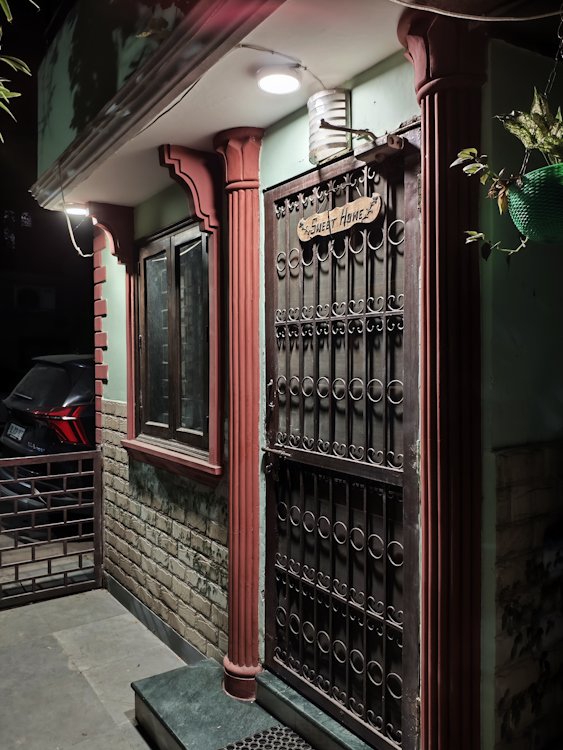
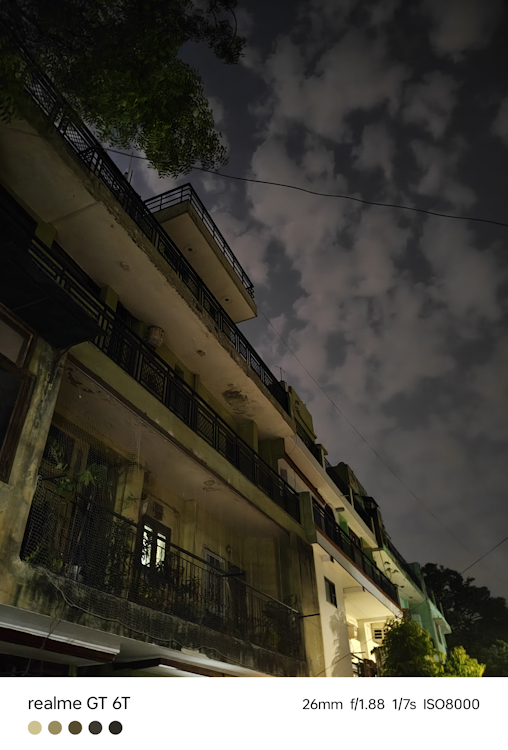

Selfies
The selfie shooter of the Realme GT 6T is better and offers more details. The POCO F6 also enhances the saturation slightly, which I won’t prefer. In portrait mode as well, the Realme GT 6T stands out, thanks to capturing more details and injecting less skin-tone-boosting, which the POCO F6 does. The edge detection and depth effect are good on both phones.




Videos
As for videos, both phones can capture up to 4K 60FPS through the primary sensor. However, at the front, the Realme GT 6T can capture up to 4K 30FPS as well. On the other hand, the POCO F6’s front shooter is limited to 1080p 60FPS.
Realme GT 6T vs POCO F6: Final Verdict

While these are two of the most powerful phones in the segment, the POCO F6 undoubtedly stands slightly taller as the better gaming phone. The Realme GT 6T, in its current state, can’t let you experience those higher graphics settings. On the other hand, the POCO F6’s chipset seems to be more in tune with games, bringing better graphics settings, and doubling the frames in an unoptimized title like Warzone Mobile.
In addition, you also get slightly better-tuned cameras on the POCO F6, while the Realme GT 6T has a better UI. Then comes battery backup, which is undeniably much more on the GT 6T. On top of that, you also get a stunning display on it with more protection. I believe that getting just a gaming phone is not enough, and you will need to be sorted on the other fronts too.
And, both these phones do that for you. If you want slightly better gaming performance and cameras, go with the POCO F6. Meanwhile, the Realme GT 6T is for you, if you’re okay with waiting a bit for it to reach its true gaming potential next month, and want a better display as well as significantly more battery backup.
Then comes the pricing of the two phones, with the POCO F6 being cheaper by Rs 1,000 at Rs 29,999. If that difference matters to you, of course, the F6 is the ideal choice. Another important thing to note is that, for that price, while the POCO F6 offers 256GB of storage in the base variant, the Realme GT 6T has 128GB to offer. Moreover, the 128GB configuration is based on the slower UFS 3.1 type as well. If that’s a dealbreaker for you and you want more storage, the POCO F6 is a no-brainer.
One thing is for sure though, if you have a budget of around Rs 30,000, and want a reliable gaming all-rounder, none of these two phones will disappoint. I’m feeling sad for future phones that will have to compete with these power monsters.








